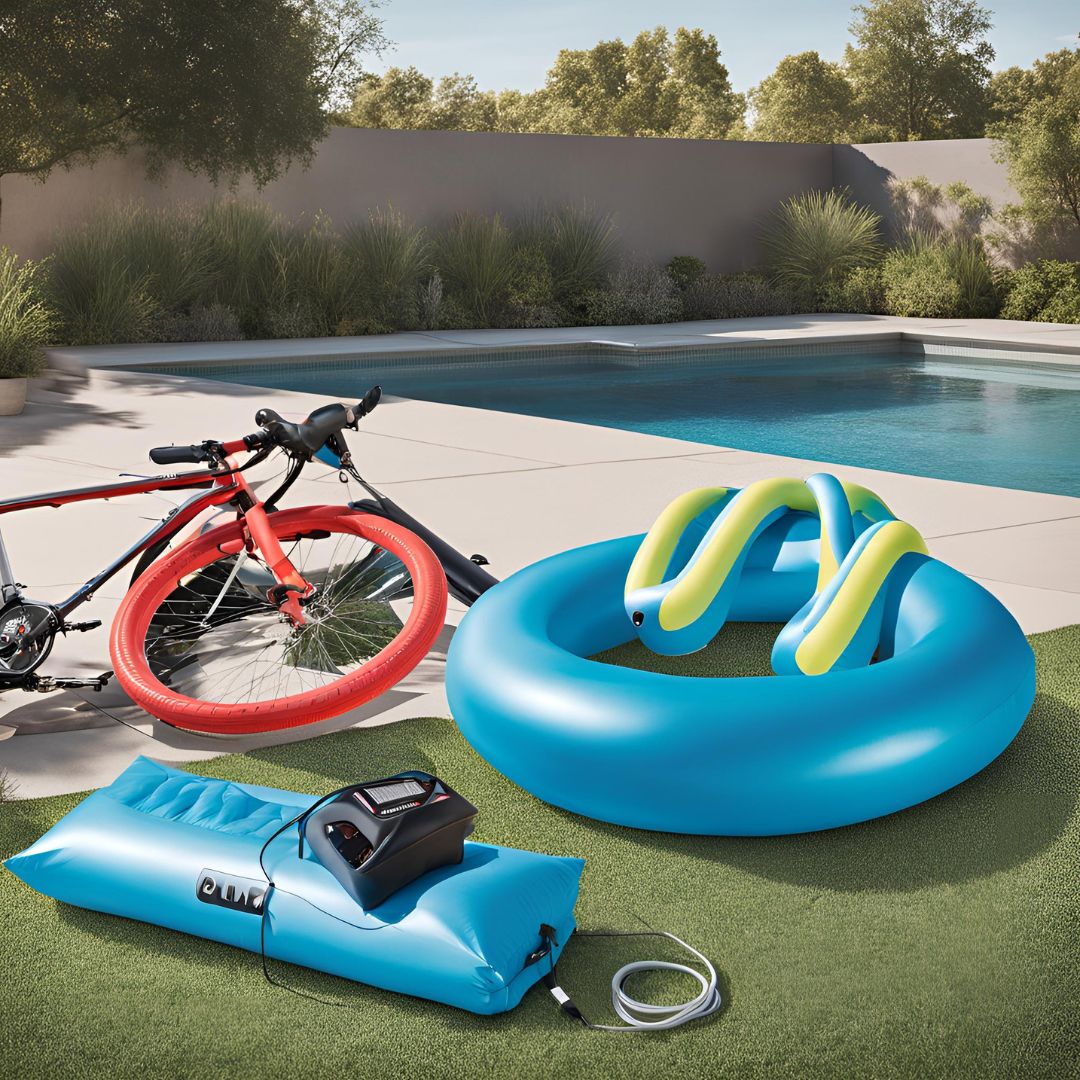How To Inflate Pool Float With Air Pump – A Fun Guide to Floatation Freedom
Let’s face it — how to inflate pool float with air pump should be a no-brainer, right? You plug it in, hit a button, and bam! You’re lounging like a royal on a giant flamingo.
But somehow, you end up in a battle of wills with your pool float, looking more like a deflated beach ball than the serene sunbather you envisioned.
So, let’s turn that inflatable fiasco into a breezy experience, filled with laughs and expert tips.
Step-by-Step Guide: How to Inflate Pool Float with Air Pump
Alright, let’s get into the nitty-gritty of how to inflate pool float with air pump. Buckle up; we’re about to transform that deflated piece of plastic into your summer throne.
1. Choose Your Pump Wisely
The first thing you need is the right pump for the job. Think of it as selecting the perfect wine for dinner – you wouldn’t pair a bold red with sushi, would you? Here are the pump options you can find on the market:
Manual Pumps: These can be your best friend or your worst enemy. They’re great for smaller floats, but when you’re trying to inflate a giant unicorn, you might wish you had more than just your lungs.
Electric Pumps: The superheroes of float inflation. They’re quick and efficient, especially if you’re dealing with larger inflatables. There are two types:
- Corded Electric Pumps: Plug these beauties into a wall socket, and you’re ready to go. Just be mindful of extension cords near water!
- Battery-Operated Pumps: Perfect for those beach trips where outlets are about as rare as a unicorn. Just be sure you’ve got fresh batteries, or your float might end up half-inflated and half-sad.
Car-Adapter Pumps: If you’re inflating your float at the beach, look for a pump that can plug into your car’s lighter port. Because who doesn’t love a little multitasking while waiting for the tide to come in?
2. Gather the Right Attachments
Next up, it’s time to find the correct nozzle or adapter. Many air pumps come with various attachments, but make sure you grab the right one for your float. Here’s what you might need:
- Wide Nozzle: Perfect for those big Boston valves found on larger floats. Think flamingos and massive pizza slices!
- Narrow Nozzle: Great for pinch valves, which are typically seen on smaller, simpler floats. You know, like the ones that don’t make you feel like you’re inflating a hot air balloon.
- Needle Nozzle: Sometimes, you’ll need this for those weird, inflatable shapes that look like they belong in a circus. If it’s pointy, it’s probably what you need!
3. Set Up the Pump
Now, let’s get to the good stuff. Whether you’re using a manual or electric pump, setting it up should be a piece of cake—or at least a piece of pool float. Here’s how:
- Electric Pump: If you’re using a corded pump, plug it into a nearby outlet. For battery-operated versions, make sure the batteries are fresh and ready to go. Attach the correct nozzle and you’re golden!
- Manual Pump: Place it on a flat surface to avoid it rolling away while you’re working up a sweat. If it’s a foot pump, just ensure you’ve got enough room to stomp down without kicking a nearby table (or your friend).
4. Attach the Nozzle to the Pool Float
Now comes the tricky part: getting that nozzle into the float without looking like you’re trying to perform some kind of inflatable yoga. Here’s how:
- For Pinch Valves: Hold the valve open with one hand while inserting the nozzle with the other. Easy peasy, right? Just make sure your hands are steady – no one wants to lose a toe to a rogue float!
- For Boston Valves: Simply push the nozzle in and ensure it’s snug. No need for a degree in engineering here – just a good push will do!
5. Start Inflating!
Time to see your float come to life! If you’re using an electric pump, this part is a breeze. Just flip the switch and watch as your float transforms before your very eyes.
If you’re using a manual pump, find your rhythm. Be prepared for a bit of a workout, but hey, that’s just extra cardio, right? Remember: if it feels rock-hard, take a step back. Over-inflation can lead to a pop, and that’s not a party trick anyone wants to witness.
6. Check for Air Leaks
Once your float is looking fabulously inflated, it’s time for the air leak inspection. This part is crucial as no one wants to float on a sinking ship!
- Listen for Hissing Sounds: If you hear air escaping, you might have a leak. Go ahead and inspect the valve; it could be as simple as a loose seal.
- Tighten and Seal: If the air seems to be escaping faster than your enthusiasm for the pool party, try tightening the valve cap or re-seating the nozzle.

Why Everyone’s Buzzing About Inflating Pool Floats
Now, let’s talk about why how to inflate pool float with air pump is such a hot topic. Why are so many people turning to the internet for help? Here’s a sneak peek into the inflatable dilemmas folks face.
The Compatibility Conundrum
First off, there’s the tricky matter of compatibility. Not every air pump is created equal, and not every pool float comes with a universal valve. You’d think it’s just a hole for air, but nooo! You’ve got Boston valves, pinch valves, and some floats that seem to have their own secret language.
This confusion leads many people to search for how to inflate pool float with air pump like it’s a treasure map to buried riches.
The Time-Sucker
Then there’s the time factor. You don’t want to be the one at the party inflating floats while everyone else is splashing around, right? If you’ve got kids or friends impatiently tapping their toes, the pressure is on! Knowing how to inflate your float quickly is essential to avoid looking like the inflatable version of a sad potato.
Tips and Tricks for Inflating Pool Floats
So, now you’re a pro at how to inflate pool float with air pump, but there are always a few extra tricks to keep in your back pocket. Here are some pro tips that’ll make your inflatable experience even smoother.
1. Inflating Larger Floats
When dealing with larger pool floats, the strategy is a bit different. Instead of inflating the entire float at once, focus on the biggest chamber first. Inflate that one fully before moving to the next. This will help keep the air pressure balanced and your float intact.
2. Deflating Your Floats
Once the day or part is over, deflating your float can be just as important as inflating it. Many electric pumps come with a deflation feature, which pulls air out like magic. For manual pumps, just flip the nozzle and let the air escape – like letting out a sigh of relief after a long day.
Pro Tip: Always deflate and dry your floats completely before storing them away. No one wants a surprise mold problem come next summer!
3. Keeping Your Pump in Top Shape
If you’re going to be inflating floats all summer long, make sure your pump stays in great condition. Avoid using it continuously without breaks, as this can lead to overheating.
Give it a little rest between floats, just like you would for your own overworked self! You should also check the manufacturer’s instructions for recommended usage times to extend the life of your pump.
4. Traveling with Your Pump
If you plan to inflate floats on the go, consider getting a portable battery-operated pump. They’re lightweight and perfect for those spontaneous trips to the beach or park. Just make sure you charge it beforehand so you’re not left high and dry!
The pump could also be the type you can plug into your car’s lighter port. Either way, this should make life easier for you

What to Do When Things Go Wrong
Even the best-laid plans can go awry, and knowing how to inflate pool float with air pump doesn’t guarantee a perfect experience every time. Here are some common problems and solutions to keep in mind:
- Problem: No Air Filling the Float
- Solution: First, check if the nozzle is securely attached. If not, reattach it and give it another go. If that doesn’t work, check for any leaks.
- Problem: Float Deflating Immediately After Inflation
- Solution: Inspect the valve carefully. A common culprit is debris stuck in the valve. Clean it out, reattach, and inflate again!
Safety First: Inflating Your Pool Float Responsibly
Safety should always be a priority, even when inflating floats. Here are some tips to keep in mind:
- Inspect Your Equipment: Check your pump for any signs of damage, especially if it’s been in storage. A frayed cord or cracked nozzle can lead to accidents.
- Avoid Overinflation: Keep an eye on the firmness of your float. If it feels rock-hard, release some air. It should be firm but still have a little give! But overinflation can lead to popped seams or ruptures, rendering the float useless
- Supervise Kids: If children are around while you’re inflating floats, make sure they’re supervised. You don’t want any little fingers getting caught in the pump or the floats.
- Store Properly: After using your float, store it properly in a cool, dry place to extend its lifespan and prevent mold or mildew growth.
The Bottom Line on How to Inflate Pool Float with Air Pump
And there you have it – the ultimate guide on how to inflate pool float with air pump. Now you’re armed with all the knowledge you need to conquer the inflatable world. Whether you’re lounging in the sun on a vibrant flamingo or bobbing in the water on a massive pizza slice, your summer fun is just a pump away.
Remember, the key is to choose the right pump, prepare adequately, and inflate responsibly. With these tips in hand, you’ll not only impress your friends but also make your summer a whole lot more enjoyable. So, go ahead and inflate away – your inflatable kingdom awaits!



